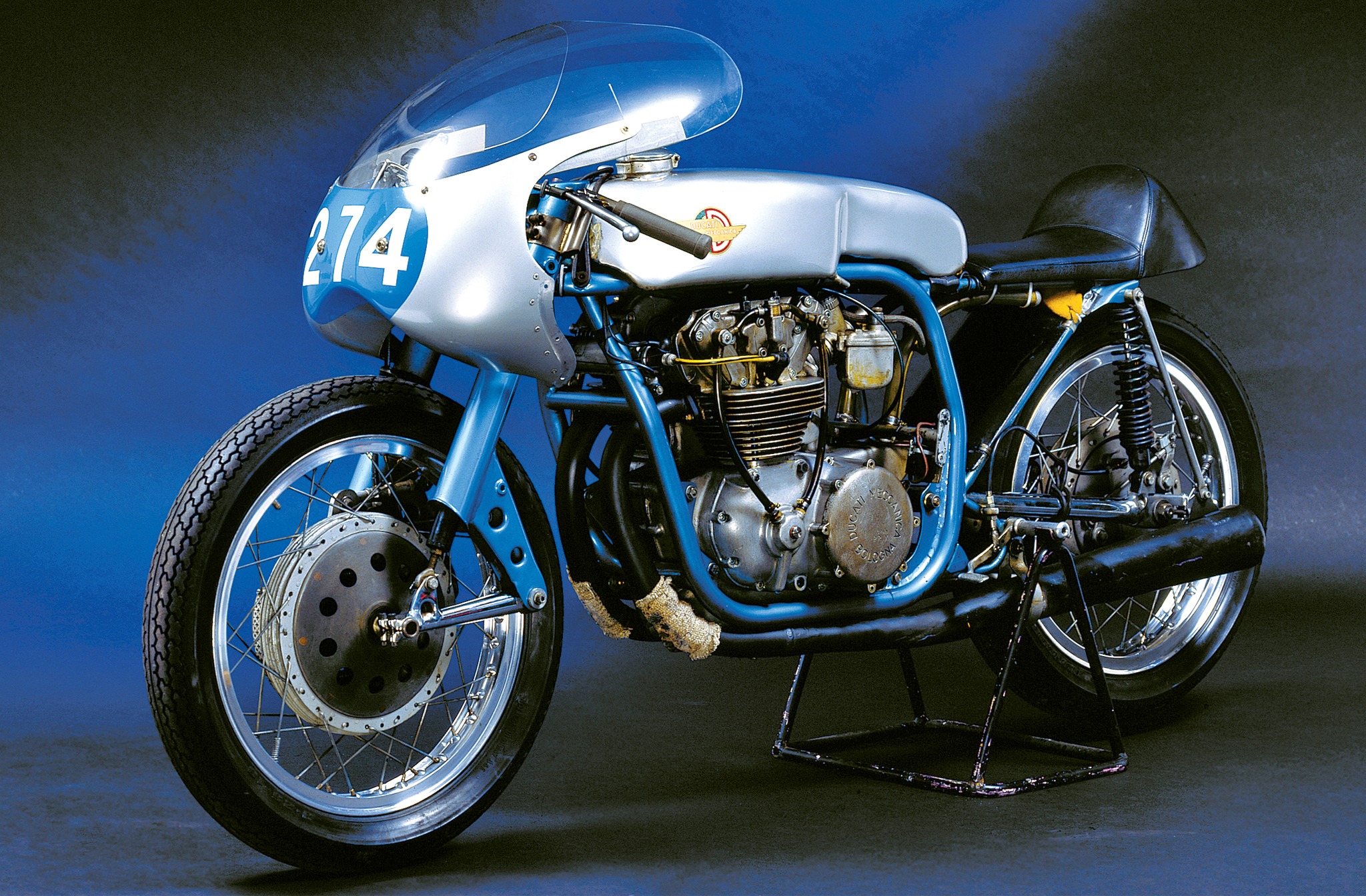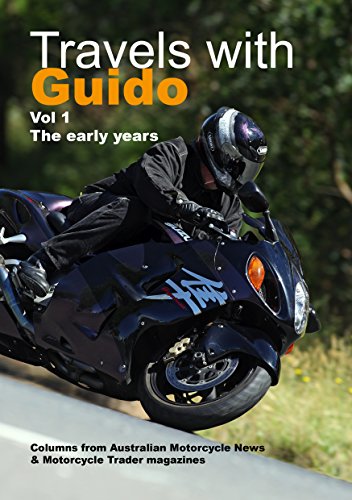Motorcycle Investor mag
Subscribe to our free email news
Hailwood's Ducati 250
(by Ian Falloon, Apr 2022)

The
troubled history of Ducati's parallel twin racer
Many
followers of Grand Prix
racing believe the greatest rider ever was Mike
Hailwood. Hailwood could ride
any motorcycle to its limit, and won races on several
makes, in a variety of
displacements, often in the one day.
In 1959 and
1960, he won all
four British titles (125, 250, 350 and 500). While best
known for his nine
world championships on Hondas and MVs, it was Ducati
that Mike was associated
with at the beginning and end of his motorcycle racing
career.
Hailwood’s father Stan
was a wealthy
businessman, and would spare nothing to see his son
succeed in motorcycle
racing. He established a team, Ecurie Sportive, to
further Mike’s career, and
purchased a double overhead camshaft (Bialbero) 125
Ducati Grand Prix single
from then British Ducati agent Fron Purslow during
1958.
In those
days Mike seemed
more interested in playing jazz than racing motorcycles
and he suffered
criticism through having a millionaire father who
provided the best equipment
and tuners. However, he quickly overcame this and
established himself as an
extraordinary talent.
Mike’s first ride on the
Bialbero was at the
Dutch Grand Prix in June 1958, and he finished tenth.
He went on to win three
races on it that year before Stan visited Italy and
arranged to take over the
distribution of Ducati motorcycles in England. In
return, he was able to obtain
a pair of factory 125 desmo singles, and the services
of factory mechanic Oscar
Folesani, for the 1959 Grand Prix season.
Hailwood was
also provided a
factory-prepared 125 desmo twin for selected events.
Soon after receiving the
desmo single Hailwood rode it to victory at Snetterton,
the first win in
England by a desmodromic Ducati. He followed this with
eleven victories in England
that year.
While the little desmo
single provided Hailwood
with his first Grand Prix victory (at Ulster), and
third in the 1959 125 cc
World Championship, Mike was always a little too large
for these diminutive
machines. Stan Hailwood believed Mike would be more
suited to the larger
capacity classes. At that stage, Mike’s 250 cc racer
was an ageing Mondial
single and Stan reckoned a Ducati twin would be the
business.
By 1959, the Ducati twin
had already been around
a few years, both as a 125, and 175. Back in 1950,
Taglioni sketched a plan for
parallel twin, and he eventually found the time to
produce a 175 twin during
1956. This was displayed at the Milan Show at the end
of the year, and Leopoldo
Tartarini raced it in the 1957 Motogiro d’Italia. He
retired with ignition and
generator problems during the third stage.
The 175 set
the basis for all
the racing parallel twins in that it featured twin
overhead camshafts driven by
a train of spur gears from a jackshaft between the
cylinders. There was a pressed-up
crankshaft consisting of two flywheel assemblies clamped
by Hirth (radially
serrated) couplings.
Complex and
difficult to work
on, the engines were beautifully constructed, with the
flywheels and big-end
assemblies machined from solid and all the gears drilled
for lightness. There
was dry clutch and exposed hairpin valve springs but
still a wide 80-degree
included valve angle. With an 11:1 compression ratio and
18 mm Dell’Orto
carburettors, the 49 x 46.6mm 175 produced 22bhp at
11,000 rpm. By 1959, this
was increased to around 25bhp but the powerband was too
narrow, the 112kg
machine too heavy, and it suffered in comparison to the
single.
Stan Hailwood persuaded
Ducati to produce an
updated 175 twin early in 1959. With a new frame, rear
suspension, and Amadoro
brakes Mike tested this revised 175 at Brands Hatch in
March. He wasn’t
particularly impressed and didn’t race it. Stan
Hailwood subsequently sold the
175 to Arthur Wheeler, but remained convinced a
larger, desmodromic, version
was worth persevering with. During 1959, Mike also had
the 125 desmo twin for
certain races, and while this wasn’t especially
successful Stan purchased two
from the factory at the end of 1959.
By this stage, Stan had
persuaded Taglioni to
produce a 250 cc twin, essentially two of the
successful desmodromic singles
doubled up. Ducati had officially withdrawn from
racing by this stage and
undoubtedly Stan Hailwood paid handsomely for this
specially commissioned
racer.
The 250 twin
was first
revealed in February 1960, but when Hailwood first flew
out to Italy for
testing it wasn’t ready. Later in February, both he and
Franco Farnè rode it at
Modena and were apparently satisfied with the machine.
The 250 shared its
55.25x52 mm dimensions with
125 single but in other respects it was a scaled up
125 desmo twin. It had a
six-speed gearbox and twin Dell’Orto 30mm SS
carburettors with flat float bowls
similar to the 125. The power was 43bhp at 11,600rpm
(at the crankshaft) and
provided the 250 with a top speed of around 218km/h.
A unique
feature of the twin
was the ability to remove one side of the engine leaving
the other intact.
Unfortunately, the engine was too powerful, and too
heavy, for the scaled-up
125 double cradle frame, even with Norton forks and
Girling shocks. The brakes
were Oldani twin leading shoe (220mm and 200mm) but the
machine was
considerably overweight (a claimed 112kg but plainly
optimistic) and suffered
from poor acceleration.
At the end of March, the
250 arrived in England
and Hailwood gave it a sensational debut at the
Hutchinson 100 at Silverstone
on 9 April when he won the 250 race. Although Hailwood
won the 250 races at
Brands Hatch and Snetterton, he soon found that while
the new Ducati was
competitive on the faster circuits it didn’t handle
well on the shorter tracks.
The machine
was sent back to
Italy for a new frame, and it arrived back in time for
Mike to win the
international race at Silverstone at the end of May.
Although the new frame
still didn’t solve the handling problems, after the Isle
of Man, Hailwood
elected to ride the 250 at the Belgian Grand Prix Spa
and came fourth.
He then took
the 250 to a
five consecutive victories on British short circuits
before Ulster Grand Prix
where the 250 appeared with another new frame. Stan
Hailwood commissioned this
new Reynolds 531 frame from Ernie Earles in Birmingham,
lengthening the
wheelbase from 1314 mm to 1,72 mm, and lowering and
moving the engine further
forward. Hailwood came fourth at Ulster but he still
wasn’t overly impressed
with the handling.
Apart from
Snetterton (where
he won on the 250 twin), Hailwood chose his Mondial for
the rest of the 1960
British season. Hailwood did ride the 250 twin early in
1961, winning again at
Snetterton but was disqualified at Silverstone as he was
entered on the
Mondial.
When Mike received a
works Honda contract Stan
sold the Ducatis, and John Surtees purchased both the
Hailwood 250s during
1961. Surtees recognized that the Ducatis were
powerful if underdeveloped, and
installed the engines in Ken Sprayson Reynolds frames
with leading link forks
as already built for the Hailwood 350.
Initially
the Ducatis were
for John’s younger brother Norman, who raced the 250
several times towards the
end of 1961. Before the 1962 season a new frame without
a lower right frame
tube was produced but Norman had little success with it.
John Hartle was set to
ride the twin in 1963 but this didn’t eventuate, however
Mike Hailwood gave the
250 one final victory at Mallory Park at the end of
March. Hailwood’s final
ride on a Ducati until 1977 was at Silverstone in early
April 1963 where he
rode the Surtees 250 twin to second behind Redman’s
Honda.
The desmodromic twins may
represent an
unfulfilled era at Ducati, but the 250 (in the hands
of Mike Hailwood) won
enough races to ensure an important historical place
in Ducati’s racing
history. Considering the amazing success of the
desmodromic singles, it was
surprising that Taglioni decided to pursue the path of
weight and complexity
with the twins.
He obviously
believed that
more horsepower was needed to win Grands Prix but
somehow lost direction by
creating a design that was excessively complicated. The
parallel twin
experience also showed that Ducati didn’t have the
resources to produce and
develop one-off racing bikes to order.
Possibly
these projects were
accepted as the economic circumstances at the time were
so difficult any
commissions were welcome. Unfortunately doubling up the
existing successful
singles was a recipe for disaster and what was really
needed was a completely fresh
approach. The twins were plagued with troubles from
fractured crankcases,
broken gears, and electrical and ignition problems.
They may
have been
sophisticated designs but their complexity made them
problematic, and their
power taxed a chassis that was inherited from lower
powered and more balanced
designs. If nothing else, the parallel twin episode
convinced Taglioni on the
virtues of light weight, balance and simplicity, almost
to the point of
obsession. All his later attempts with multi-cylinder
racers were half-hearted.
-------------------------------------------------
Produced by AllMoto abn 61 400 694 722
Privacy: we do not collect cookies or any other data.

Archives
Contact





